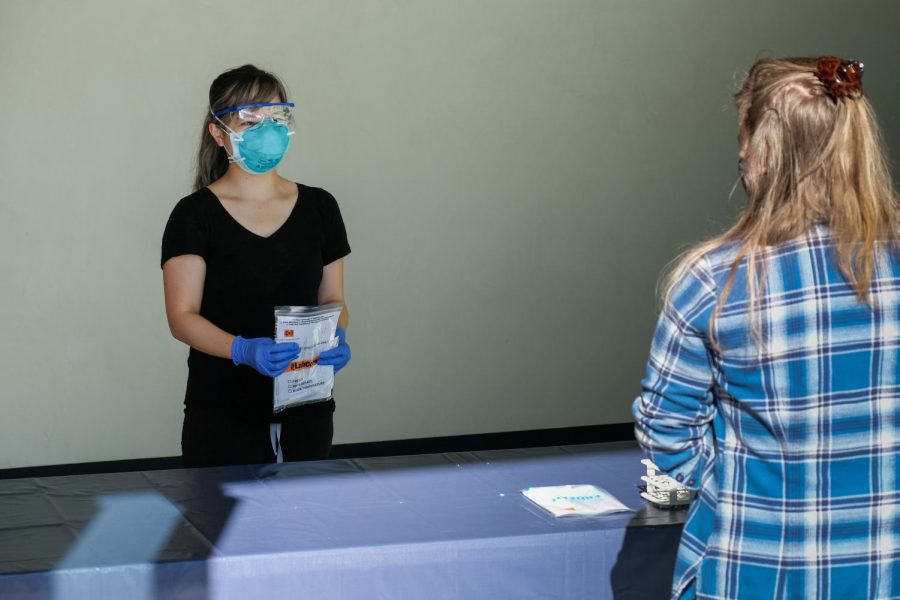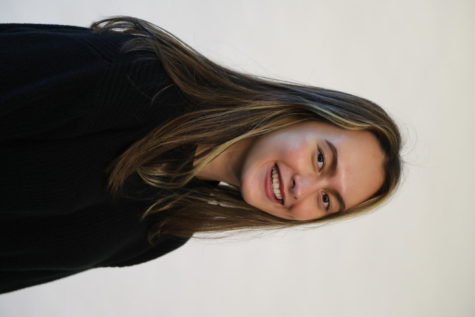What Happens if Someone at Menlo Tests Positive for COVID-19?
A Menlo community member receives a COVID-19 PCR swab test at the One Medical testing center on campus, inside the new Spieker Center for the Arts. Menlo has established contact tracing and privacy protocols to prepare for the possibility of a member of the school community testing positive for COVID-19. Photo courtesy of Pete Zivkov.
December 11, 2020
Following recent COVID-19 case spikes in San Mateo county and in anticipation of the return to hybrid learning in January, the administration is preparing for possible COVID-19 cases within the school.
“You have to assume it’s going to happen at some point,” Upper School Director John Schafer said. “We’re assuming that someone will test positive for [COVID-19] or come into contact with someone who has, and we will do everything we can to make sure that person is safe and everyone who interacted with that person is safe.”
As the school is operating under the assumption that someone in the community will test positive, the administration has implemented protocols such as student surveys asking where they sat at lunch that will help make the process of contact tracing much easier when the need arises. The school has been split into eight zones that cover the different outdoor areas across the quad. “That’s the logic behind why we ask you to tell us which zone you sat in [at lunch],” Schafer said. “If [a student] tested positive, we would know who was in [their] lunch pod, who was in [their] class, who used the same bathroom.”
The protocols help simplify the process of figuring out who the school needs to contact with information regarding their exposure to the person who tested positive and recommended guidelines such as quarantine. “We would be able to draw a circle around that group fairly quickly,” Schafer said.
The school is also attempting to broaden its contact tracing to other methods. “The school is actively researching app-based solutions that may also provide additional insight to make our contact tracing efforts more specific, but we haven’t yet found the right one for our context,” Health Coordinator Joan Barada said in an email to The Coat of Arms. One existing app is the CA Notify app, which aims to stop the spread of COVID-19 through the use of Bluetooth on smartphones. The app will send alerts through a person’s phone if they are in close contact with someone who tests positive, according to the CA Notify homepage. “Add your phone to California’s exposure notification system to get COVID-19 exposure alerts and to protect those around you,” the CA Notify homepage says.
Privacy is also critical when it comes to alerting those who may have been in contact with someone who tests positive, according to Barada. “As with any contact tracing, we uphold [The Family Educational Rights and Privacy Act] and [Health Insurance Portability and Accountability Act] laws in relation to student, faculty and staff privacy if there is a suspected or confirmed COVID case,” Barada said.
“The Family Educational Rights and Privacy Act (FERPA) is a federal law enacted in 1974 that protects the privacy of student education records,” according to the Centers for Disease Control and Prevention (CDC). While FERPA is a broad overview of student information that cannot be legally shared within schools, the Health Insurance Portability and Accountability Act (HIPAA) is standard specifically for the sharing of health records, in this case applied to schools such as Menlo. “[HIPAA] is a national standard that protects sensitive patient health information from being disclosed without the patient’s consent or knowledge,” according to the CDC. Therefore, in compliance with these laws, information such as a student or faculty’s name will be kept confidential throughout the contact tracing process, according to Barada.
In addition to protocols intended to simplify contact tracing in the event of a positive test, Menlo has anticipated a situation in which a teacher would be unable to teach due to contraction of COVID-19. “We’ve got a fleet of substitutes lined up so that if a teacher was sick, we could keep class going. For example, because I have a history background, I could be a history teacher for a few weeks,” Schafer said.
However, Menlo will not ask its teachers to continue to substitute if the absence becomes prolonged. “If the teacher was sick for a long time, we would have to go out and find another teacher,” Schafer said.
Positive test results will only result in school closure when there are enough cases to warrant such action. “The school will follow San Mateo County guidelines, which recommend closure ‘when there are multiple cases in multiple cohorts […] or when at least 5% of the total number of teachers, students, and staff are identified as cases within a 14-day period,’” according to Menlo’s Back to Campus Plan from October.
Additionally, intensive disinfection of the entire school must take place before the school will reopen in either of these scenarios, much like when Menlo first closed its campus last March due to a staff family member’s positive test result. “Once the School closes, it will not reopen until after 14 days have passed and deep cleaning of school buildings, public health investigation, and consultation with the San Mateo County Health Department have occurred,” the plan said.
As it has done since the first school closure last March, Menlo continues to approach COVID-19 protocols with an abundance of caution, according to Schafer. If a faculty member or student shows signs of COVID-19, they should adhere to the COVID-19 FAQs guidelines located on Menlo’s COVID-19 Resource Page, Barada said. “Any community member who shows symptoms of COVID-19 while off campus should stay home. Should an employee or student demonstrate COVID-19 symptoms while on campus, they need to report their symptoms to the school nurse at nurse@menloschool.org and immediately go to an open-air medical tent where the nurse will oversee the appropriate next steps,” according to the COVID-19 resource page.



